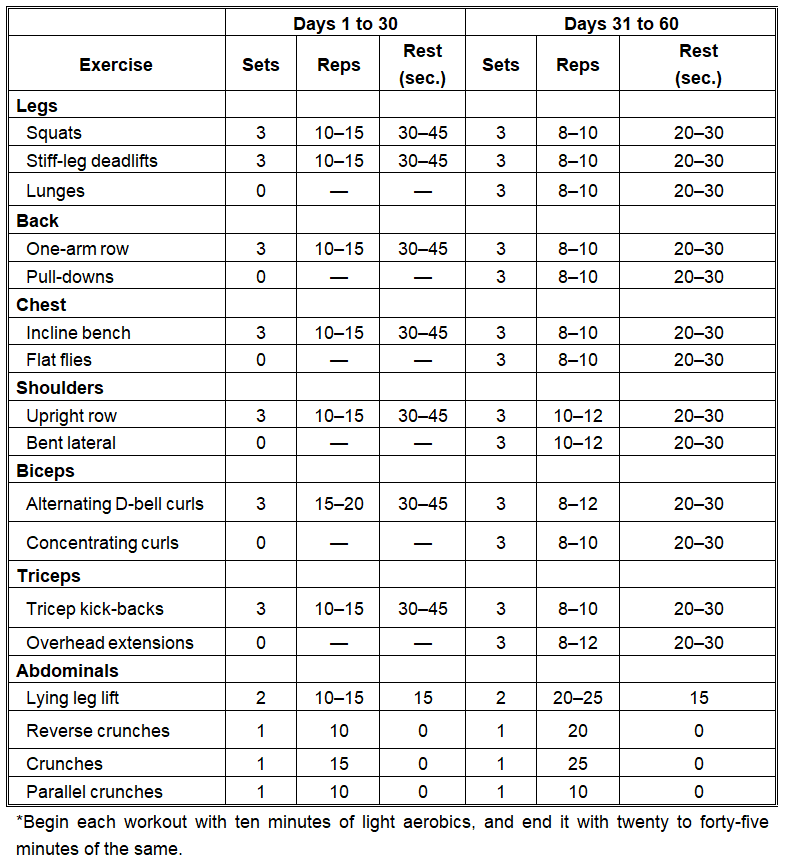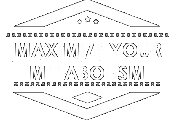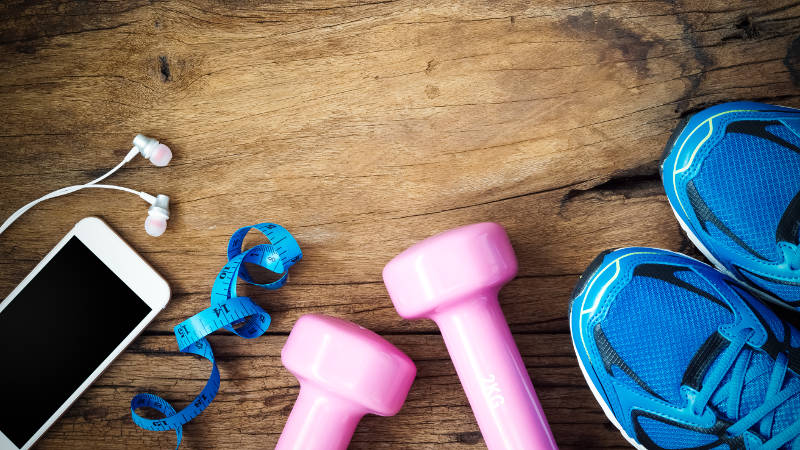“The 2nd part of this 7 day weight loss plan will boost your metabolism and unlock your true fitness potential. It’s all laid out here step by step.”
Congratulations! You’re one of a relatively small contingent of readers who have made it this far. Most people don’t come back after reading the 1st part of the weight loss plan. What your persistence demonstrates is that you’re one of the top 10 percent of the population who truly want to improve their health and their appearance—and you will succeed! Now let’s maximize your metabolism. First, we’ll start the 2nd part of this weight loss plan with training your cardiovascular system.
Day Four Of Weight Loss Plan.
Your metabolic fitness is an essential component of an effective weight loss plan. And metabolic fitness includes both aerobic and strength-training elements that work together to produce total metabolic health. You simply cannot have the whole package without including physical training and a systematic, healthful diet.
As you learned previously, aerobic (cardiovascular) exercises are those that burn huge amounts of oxygen. Do you remember what they are? Here are a few examples:
- running
- jogging
- aerobics classes
- spinning® classes
- power walking
- indoor rock climbing
Exercises such as these place heavy demands on your heart and lungs; they are excellent methods for promoting cardiovascular fitness. Cardiovascular exercise is also known to:
- Burn calories and help regulate appetite
- Lift your mood
- Relieve depression, boredom, fatigue, and stress
Regardless of the program you choose, I recommend that your entire exercise program include the following five elements:
- Aerobic warm-up
- Minor stretching
- Aerobic and strength conditioning
- Aerobic cool-down
- Final, more-detailed stretching
Now not everyone will have the time for all five of these activities. But you should never miss your warm-up, or the actual aerobic and strength-training session, or your cool-down.
The stretching is very helpful, but for purposes of this weight loss plan the stretching is slightly less important than the cardiovascular part. However, you should not let more than thirty days go by without including a stretching component in your exercise routine.
The warm-up elevates the core temperature of your muscles.
It increases the pulse rate and blood flow throughout your body, and gets your body ready for exercise.
Stretching prepares the body for exercise.
Stretching improves the elasticity of the muscles, which helps to prevent injury.
The aerobic exercise you choose should be performed within your target heart range (THR).
The simplest way to determine your THR is the following formula, which gives lower and upper bounds on the heart rate you should aim for:
(220 minus your age) multiplied by 0.70 = your lower bound
(220 minus your age) multiplied by 0.80 = your upper bound
Monitor your heart rate by using a heart-rate monitor strapped to your chest (this can be purchased for around $75 in any fitness store). Keep your heart rate within your target heart range (THR) during your entire period of aerobic exercise (that is, keep it between the lower and upper bounds given by the above formula).
The cool-down is really just the opposite of the warm-up.
The rate at which you exercise (and your heart rate) should slowly decrease during the cool-down, thereby allowing your body to eliminate harmful lactates and return to a normal temperature.
Set short-term goals.
Now set some short-term goals, say weekly, for the amount of time you will spend on the actual aerobic-conditioning phase of your exercise routine.
If you can perform only ten minutes’ worth of moderate cardiovascular exercise at this point, then setting a goal of working up to a thirty-minute exercise period within the next seven days is neither attainable nor safe.
Pushing yourself too hard will not increase your metabolism.
What is needed for an increase in metabolism is persistent training (that is, being sure not to miss your scheduled training sessions).
Increasing the length of your cardio session by, let’s say, five minutes on every third workout is a great goal. It’s a goal that will constantly increase your metabolic rate.
But stop increasing the length of your cardio workouts once you get up to sixty minutes.
As for the intensity of each of your training sessions, remember to monitor your heart rate so that you will always be in the correct fat-burning, metabolic-enhancing range. Whatever your level of aerobic/cardiovascular activity, select and write out your goals, then focus wholeheartedly on achieving those goals. And do it now.
Today’s assignment
- Write out your cardiovascular goals. For example, to do some form of aerobic conditioning four times each week, for thirty minutes each time.
- Commit to keeping to the following schedule for the next thirty days:
- Five minutes of a general warm-up
- Five minutes of light stretching
- At least thirty minutes of aerobic conditioning (we’ll add your strength training tomorrow, on day five)
- Ten minutes of a general cool-down
- Ten minutes of light stretching
- Never set a schedule without actually starting to follow it that very day! Start and complete your first aerobic session according to the schedule laid out above.
- Write out a schedule of the exact times at which you will train each day for the next few days. In fact, you should get into the habit of writing out the next day’s schedule each night before you go to bed.
This is a good place in the weight loss plan to make a side note regarding your journal entries. You should be writing out your goals on a regular basis, either daily or weekly. The more you write and re-write your goals, the more ingrained in your subconscious they will become. So make this a regular practice, and never miss a journal entry.
Building Dense, Well-Toned Muscles
The other half of the fitness equation is the development of muscle strength and endurance, what we’ll call strength training. Today, day five, you’ll begin to accelerate your progress tenfold, by incorporating strength training into your weight loss plan.
Day Five Of Weight Loss Plan.
Muscle endurance is the ability of muscles to apply a sub-maximal force repeatedly or to be exercised over an extended period of time. Here are some common means of building muscle endurance:
- free weights
- exercise machines
- push-ups, sit-ups, chin-ups
Of these three, my favorite is the use of free weights. No matter what your goals are, free weights give you greater control over your destiny. In the absence of free weights (dumbbells or barbells), you can resort to push-ups, sit-ups, etc.; however, your progress will be slower and harder to track.
What are the benefits of muscle conditioning?
One of the principal benefits of muscle conditioning is that muscles serve as the body’s motor; muscles burn most of the energy in the form of food the body ingests which makes muscle conditioning vital for weight loss goals.
Losing muscle density while continuing to take in the same amount of energy in the form of food has the undesirable outcome of causing you to put on weight in the form of fat.
When we reach our thirties, we begin to lose muscle mass, for a myriad of reasons.
As we age, our basal metabolic rate decreases by about one-half of one percent per year.
Thus, our overall metabolic rate will naturally start slowing as we get older unless we can increase our muscle density. The way we do this in this weight loss plan is through strength training.
Keep in mind that every pound of muscle burns approximately fifty calories per day.
Thus, for every pound of muscle you gain, you can eat fifty additional calories’ worth of food each day without gaining weight in the form of fat.
Better yet, make your diet a bit more healthful and gain a few pounds of muscle density, and then see what happens. What you will undoubtedly find is that you’ll have a rapid drop in body fat on account of your heightened metabolism!
Obviously, the opposite is also true. Lose a pound of muscle mass (and you’ll lose a lot of muscle mass if you don’t exercise regularly and properly), and you’ll have to cut back on your food intake by fifty or more calories a day in order to avoid gaining weight.
Traditionally, weight-loss science has taught that optimum metabolism can be achieved by balancing the sources of energy.
In short, what goes in must equal what goes out. If the energy equivalent of the food you eat is more than the energy you burn, you’ll gain weight. If you burn more energy than the equivalent of what you ingest in the way of food, you’ll lose weight.
However, that’s not the whole story. There is also an adaptive effect of dieting:
- The greater the number of times you restrict your calories for a prolonged period of time, the slower your metabolism becomes.
- The slower your metabolism, the more calories your body will store as body fat the next time you eat.
The best way to combat this natural tendency to conserve energy is to reset your metabolic rate with a comprehensive program of strength training and aerobic activity. A balanced fitness program will help you make weight loss a part of your life.
It’s far more efficient to use exercise as a metabolic-boosting and fat-burning strategy for losing weight than it is to count on diet alone. In fact, we tend to burn off calories both during and after exercise. Strength-building exercises fire up our caloric “furnace” and raise our resting metabolic rate. Hence, strength-building exercises are a vital part of this weight loss plan.
Weight training has the added effect of breaking down muscle tissue.
In reality, you injure your muscle tissue when you lift weights, but if you rest the affected muscles and supply them with proper nutrients, they’ll automatically seek to protect themselves from further injury by becoming stronger and more responsive. This may sound like a harsh, masochistic approach to fitness, but it’s totally natural and very good for your health.
Your body adapts to the stress of weight training by . . .
- repairing the injured muscle tissue
- and then stimulating growth of new muscle tissue in order to overcome the additional workload.
In essence, your muscles become stronger and denser to overcome the added stress.
Now don’t be alarmed. I know what you’re thinking: “It sounds as if I have to become a bodybuilder or at least gain tons in the way of muscular size.” That’s not what muscle density means. We discussed this earlier, but I feel compelled to review it now.
- Muscle density refers to the strength, health, and tightness of your muscles,
- while muscle size refers to their volume.
You can greatly increase your muscle density without increasing your muscle size!
If your goal is to gain in muscular size, slight modifications can be made to this program to accomplish that goal. But this weight loss plan is focused on gaining in muscle density, not size.
Since strength-building exercises exert stresses on your muscles, they require an increased flow of blood in order to carry on their restorative and strengthening processes.
- When blood is forced into your muscles during your weight lifting program, it helps speed up the repair process in your muscle tissues.
- As they rebuild themselves, they become denser and stronger than they were before.
That’s why it is so important for you to follow your strength-training regimen to the letter, and to combine that program with a good diet and proper rest.
Your strength-training routine
Always start out with an easy strength-training regimen, perhaps with a one-set, ten-rep program of eight to ten different exercises, two or three times a week.
Your normal routine might include:
- a warm-up,
- followed by some squats,
- and then some pull-downs, bench presses, bicep curls, tricep push-downs, side laterals, incline sit-ups (or leg lifts),
- and finally a cardio regimen.
Make sure you do your exercises in the proper order.
Typically, your personal trainer (if you’re lucky enough to have a good one) will recommend starting with a larger muscle group and working your way down to a smaller one.
Always train your muscle groups in an organized, systematic fashion. And complete all the sets for each exercise (if you’re doing more than one) before going on to another exercise.
Once you establish a particular order in which to work your muscles, stick to that order (unless otherwise noted by your trainer) for thirty days before modifying it and adding variety.
Exercise sets
Just a refresher:
- A rep (short for “repetition”) is a single performance of one particular weight-lifting or exercise movement.
- A set consists of the sum total of all the times that you engage in a particular movement in succession before taking a rest.
The best exercise system for increasing your metabolism is to do three to four sets of eight to twelve reps each.
In this system, you should choose a weight that can be lifted ONLY eight to twelve times (meaning that you are actually incapable of lifting the weight one more time after you reach the eighth or twelfth rep, respectively).
Then you should repeat the sequence two or three more times (that is, do two or three more sets). And allow just enough rest in between sets for you to recover.
Normally, your rest time between sets will be about thirty seconds.
The secret of progressive resistance
As muscles adapt to a particular level of resistance (for example, the amount of weight you lift or the amount of rest time between sets), you should gradually increase your resistance, either by:
- increasing the amount of weight you lift or
- decreasing your rest period between sets.
This must occur if you are to continue to reap the benefits of the exercise in the form of denser, stronger muscles and an ever-increasing metabolism caused by those denser muscles. If you don’t increase your resistance from time to time, your program will still be beneficial, but you probably won’t develop the muscular density that you have set as your goal.
Progressively increasing your resistance is your key to muscle density and metabolic enhancement through anaerobic (weight) training. The progression principle requires that as soon as the weight you are lifting is no longer causing sufficient stress on your muscles, you must either increase your resistance or decrease your rest time between sets. That way, you’ll ensure that the workout continues to be a challenge for you.
Always exercise in proper form.
The key to realizing the maximum metabolic benefit through weight training is found not in just doing an exercise—regardless of style or form—but in doing it correctly, so that you’ll get the most out of every exercise you do.
Your exercising motions should be clean and fluid, and directly in line with the proper axis of the muscle being worked.
If you can possibly help it, you shouldn’t allow your line of exercise motion to stray. You can gain instruction in how to perform any given exercise correctly from a fitness coach or personal trainer at a good health club.
In addition to lifting form, lifting speed has a major effect on the flow of blood to your target muscles.
And while you might think better results are to be realized from lifting weights at a faster pace, the opposite is actually true.
Although fast lifting creates a certain momentum, it doesn’t promote optimal blood flow to the muscle. So it pays to slow down a bit. In a previous article titled Weight Lifting Program, we talked about lifting speed in great detail:
When you lift weights, take one to two seconds for each lifting movement (the positive phase) and three to four seconds for each lowering movement (the negative phase – where you slowly return the weight to its starting position).
Always listen to your body. If your body tells you there’s something that isn’t right, then stop the exercise immediately. And rest for a few days before attempting that particular exercise again. But continue with all other aspects of your training and diet.
The next thirty days
Here you are! The next thirty days will change your life, forever! Have you been completing your daily activities and exercises from this weight loss plan so far? If not, stop here and make sure you’re on target up to this point. Then once you are, you may proceed.
The exercise routine presented in the table below is a sample of one that I used with several clients of mine who had made tremendous progress and surpassed their goals. I’ve included it here in this weight loss plan. The exercise routine is here not necessarily for you to follow. It’s here so that you can see what a well-structured routine looks like. Study it and then create your own routine, using the one given in this weight loss plan as a skeleton to build upon and personalize for your particular level of experience.
The clients who used this routine had already had a fair amount of experience in exercising. And they knew all about proper form for each of the exercises listed in the table. What they did not know was how to put their knowledge to use to achieve the results they wanted. Only after years of trial and error did they decide to consult me. This exercise routine, which I assigned to them, brought not only the kinds of results they sought but many more.
Today’s assignment
- Review the exercise routine that’s laid out in the following table and make any modifications you see fit. But keep the general structure, such as the order of the exercises. You may even want to keep the exercises themselves.
- Before your first workout, write out a clear and concise goal for what you want to achieve in the next thirty days of training. Then commit to never missing a workout. You might wish to use one of my favorite slogans: “miss your favorite television show, but never miss one of your training sessions.”
- Have fun. This is not work. This is the way you scientifically and systematically reach your goals for this weight loss plan. The process can be fun, but you must force yourself to be persistent.

Day Six Of Weight Loss Plan.
We’ve already talked about the importance of a personal journal in helping you keep your eye on what’s going on in your weight loss plan. But now we’re going to explain precisely how to build your goals by use of your journal. In the process of doing that, we’ll be planning your physical destiny.
I once heard a professional speaker named Zig Ziglar give an explanation of the importance of goals. I have used his approach to achieving goals many times, and I’d like to share it with you now.
Ziglar told of a world-famous archer who could hit the bull’s-eye using a bow and arrow nearly every time he attempted it. He went on to say that he could teach anyone to be more accurate with a bow and arrow, and even to hit the target more often on average—and closer to the center of the bull’s-eye—than that expert archer could. The way Zig proposed to do this was to blindfold the archer, spin him around several times, and then give him no clue as to where the target was.
That may sound silly at first. How could this world-renowned archer possibly hit a target if he were blindfolded and dizzy? But it very astutely illustrates my point about setting goals:
You cannot hit a goal you do not have.
Setting goals is a vital part of many of our accomplishments. In fact, I’d be willing to bet that you’ve never achieved anything worthwhile in life without first having set the attainment of that particular milestone as a goal. You may not have been aware that you were setting a goal. And maybe you did not put your goal down on paper. You may not even have thought of it as a goal. But you did desire to attain it, and so you subconsciously set that goal in your mind.
You may be able to speed up the achievement of your goals by following the formula given below, but only if you are persistent in your efforts.
Your formula for success
- Set a goal for yourself.
- Become highly passionate about attaining this goal.
- Clearly write out your goal.
- Write out a detailed “plan of action,” with monthly, weekly, and daily steps, and be persistent in following your plan.
- About thirty times each day, think about how great it will be to have achieved this goal. In essence, become obsessed with its attainment.
- Stay on top of your plan of action. And if you notice that it isn’t working, study the situation and then make changes to your plan to help improve upon it.
Today’s assignment
- Have your number-one goal in front of you when you set out to do today’s exercises. If you don’t know your number #1 goal, then complete the exercise in the article, Need To Lose Weight (Now!).
- No goal can be properly set or achieved without a sufficiently strong desire for its attainment. Write out, in a special place in the front of your journal, exactly why you desire to achieve your goal. If you are really on track, you’ll get a bit emotional about it. If you don’t get emotional about your goal, then it’s not the right goal for you. And you probably won’t have enough desire to be persistent in trying to achieve it.
- Write out a clear description of your goal. As you do this, you can follow an approach that’s similar to what you used in doing step #2 of today’s assignment. But you need to chisel down the description of your goal to a powerful two- to three-sentence statement that gets you focused and jazzed up just by reading it.
- Neatly rewrite the description of your goal at the top of a clean page in your journal. A line or two below that, write the words “Plan of Action.”
- Now get very detailed, and write a list of everything you need to do to reach your goal.
- Finally, write out exactly how you will achieve each of these “sub-goals.”
- As I said before, you need to be flexible in your approach. Modify your plan if you figure that by modifying it you’ll be likely to reach your goal even sooner. But be careful: Study your plan and your potential modification carefully. Don’t rush into any changes to your plan. If you find yourself making frequent or rushed changes, then you know you’re just procrastinating—and ultimately setting yourself up for failure.
At this point in the weight loss plan, I’d like to include a brief discussion on being flexible.
I prefer to illustrate my view of flexibility like this: Picture a field with two trees in it, one of them large, about fifty feet tall, and strong looking; the other still young, only about ten feet tall, and relatively thin. If only one of these trees survives in a major windstorm, it won’t be the larger one, the one that refused to bend in the wind. The tree that will survive is the younger, smaller one, because it was flexible and let the wind bend it temporarily.
Now, don’t get me wrong; I am very adamant about holding to my vision and my goals. But the approach I take to reaching my goals, and the approach you take to reaching yours, must be filled with desire, must be written out clearly, and must be flexible enough to be modified if necessary.
- One additional element that’s absolutely essential in setting goals is a deadline. You will reach none of your goals on time if you have no deadlines! Make sure you set a reasonable and attainable deadline for yourself, but one that scares you a bit as well!
Day Seven Of Weight Loss Plan.
This is your day for rest and play. As you know, all work and no play makes Jack (and Jill) just as dull as can be. And though you should reward yourself once in a while, you’re on a mission right now. And you want to keep up the momentum for the next thirty days without veering off course—not even once.
The resting and playing I’m referring to here are to be physical in nature. This is your chance to rest your body and exercise your mind.
Yes, I know, you think you’ve been exercising your mind the whole time you’ve been reading these articles and doing the exercises laid out herein. But now we’re going to put your mind through mental boot camp. We’re going to crank up the volume on your desire to attain your goal. And most importantly, we’re going to set up a “success mindset” for you.
You may recall that a few articles back I told you that when you train with weights, rather than just doing aerobic exercises, your body responds by burning calories during your exercise routine as well as for a long time after you’re finished exercising for the day. I used the example of burning calories (body fat) while you sleep.
Well, now we’re going to program your mind so that it’s focused on achieving your goal even when you’re focused on your normal daily activities. Let’s think of this process as one of training your mind so well now that you can run it on autopilot later. Even when you’re not focused on achieving your goal, your mind will be drawing it into your life!
Okay. Enough explanation. This is a hard-core, “just-do-it” kind of exercise, so let’s move on to the daily assignment.
Today’s assignment
- You have already written a really good affirmation (the two- to three-sentence statement of your achieving your goal). Now take that affirmation, and read it out loud at least a hundred times today. Do this in a place where no one can hear or see you! In fact, don’t tell anyone about this exercise, or even that you have a goal.
- Let others see the results in full before you let them in on the existence of your goal or how you have accomplished it.
- Take several breaks from your normal day today, and, with great excitement, repeat your success statement ten to twenty times. When you do this, make sure you’re visualizing yourself as having already achieved your goal.
This is very important, so I’ll say it again:
When you repeat your success statement, make sure you are highly emotional about it (get excited) and visualize yourself as having already achieved your goal (see yourself in the shape you’re aiming for—and see yourself being congratulated by others).
- Even when you’re not repeating your success statement, stay focused on the mental picture you have of yourself having already achieved your goal. At least four times today, take five minutes to sit quietly in a room where you won’t be disturbed. First relax, and then clearly visualize yourself having already achieved your goal.
- See the colors, hear the compliments of others, feel the clothes you have on, feel how great your new body feels. Get as many of your senses involved as you can.
- I know this will take time out of your day, but it will make a dramatic impact on the speed with which you reach your goal. And the faster you reach your physical goal, the faster you can become more successful in all other areas of your life.
- Remember, not being in top shape holds you back in every aspect of your life. You may not understand that now, and that’s OK. Just take it on faith that once you’ve gotten into top shape physically, it will be a lot easier to achieve all your other goals—financial goals, relationship and family goals, business goals, etc.
- At the end of your day, while lying in bed, repeat your success statement to yourself. Again visualize yourself as having achieved your goal (this time in a relaxed state of mind—don’t get excited or emotional). Do this over and over until you fall asleep. Make this the last thing you think about as you drift off. This will help to deeply root your affirmation in your subconscious mind.
That’s it! You’ve done it!
You’ve completed the most powerful Seven Days of Training that you could ever come across. And you’ve done this weight loss plan all on your own!
Actually, you aren’t quite finished yet! Remember that you are to use what you learned in this website (about yourself and about fitness) to continue these activities for a period of at least thirty days. Don’t stop doing any of the activities you’ve been engaged in during the past seven days. Indeed, don’t stop doing anything you’ve learned, regardless of where it’s presented in this website.
The exercises prescribed for this seven-day weight loss plan were designed to simply get the ball rolling. It’s now your responsibility to keep it rolling. Your degree of success will depend by the extent to which you keep moving forward, daily, in each of the areas we’ve discussed.
Whenever you find that you aren’t progressing fast enough or that you aren’t heading in the right direction, just review what was presented here and figure out what aspect of this weight loss plan you’ve become slack on.
- If you get to the point of needing an extra kick in the rear end, reread the entire article on Fitness Motivation Tips.
- If there’s one particular exercise in this weight loss plan that you don’t feel like doing, that’s almost surely the one that’s holding you back!
- And when you can, get a massage to accelerate the healing process and reduce stress.
I’ve successfully used the information in this weight loss plan with thousands of participants at my health clubs. I know it works. I know it will work for you if you follow it faithfully.
And remember this:
I respect you, and I’m very proud of you for going through this weight loss plan. I know what it takes to maximize your metabolism. And I know that these last seven days have been hectic for you. But keep in mind that there are lots of people out there who—like me—definitely want to see you succeed. And you’re not alone in this; I’ll always do my best to answer your health and fitness questions.
Important…
Sign up for my free weekly e-mail newsletter. It’s my way of keeping you up-to-date on the latest research that I, and my team at the National Metabolic and Longevity Research Center come across. Signing up today also qualifies you for free lifetime updates on all the material in this website. Good luck, and please keep in touch.






